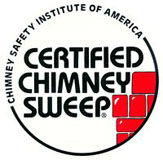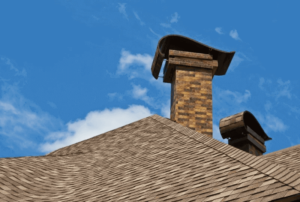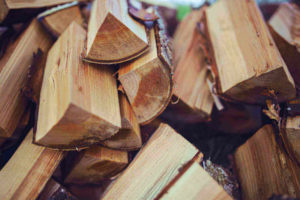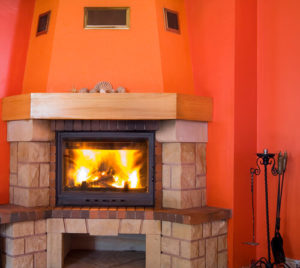Fall and winter are the busiest season of the year for fireplace use – and for chimney sweeps. While fireplaces are great for keeping our homes warm and creating a welcoming atmosphere, they need to be maintained to burn safely and efficiently. Before hiring someone to come clean your fireplace, however, it is important to ensure you are working with a CSIA certified professional chimney sweep.
What is a CSIA certification?

The mark of a CSIA certified chimney technician
The Chimney Safety Institute of America, or CSIA, is a nonprofit organization founded with the mission of improving public and professional fireplace education. Certifications must be earned through a rigorous training, testing, and certification process. Topics include:
– Local and national building codes
– Basic chimney construction and draft dynamics
– Installation techniques for fireplaces, inserts, and stoves
– Current EPA emissions standards
– Best practices for chimney professionals
CSIA certifications are not for life; sweeps must take continuing education courses as well as pass a re-certification test every three years. This ensures that all CSIA certified sweeps are up to date on the latest technological and safety advancements in the industry.
Why being certified matters
Brushes, tarps, and a truck may help someone look the part of a chimney sweep, but they often lack the education, experience, and expertise to correctly care for your chimney system. There are a number of things that set professional, certified chimney sweeps apart:
– Code of ethics. CSIA certified chimney sweeps sign and follow a strict code of ethics. This protects homeowners as sweeps are held to strict standards; the code of ethics prevents unsavory business practices, and sweeps found in violation can lose their certifications.
– National recognition. CSIA certifications are recognized – and held by – sweeps in all 50 states. The national recognition of the CSIA certification means these sweeps are often quoted in news stories or other publications as experts in the field.
– Reciprocal trade relationships. As a widely recognized professional group, the CSIA maintains reciprocal trade relationships with trade groups such as home inspectors, realtors, and homeowners associations.
Questions to ask your chimney sweep
Before hiring a chimney sweep to work on your home, there are several questions you should ask.
– How long has your company been in business in this area?
– Will the chimney sweep who works on my home be CSIA certified?
– Can you provide references from any current customers?
– Does your company or the individual chimney sweep carry liability insurance?
– Do you have any open complaints with the Better Business Bureau?
Trust a certified chimney sweep!
Since 1977, Jack Pixley Sweeps has been providing quality and trustworthy chimney services to our friends and neighbors in Minneapolis, St. Paul, and beyond. We are proud that all of our chimney sweeps are CSIA certified; we have some of the most knowledgeable sweeps in the industry, allowing our customers to get high quality chimney services. If you are in the Minneapolis area, contact Jack Pixley Sweeps for an appointment with a CSIA certified chimney sweep today!
Identifying issues with your firebox or the chimney structure can be easy, especially with chimney components that are accessible with visible damages. However, the flue, on the other hand, is a different story. With 15 feet – or more – of tight, enclosed flue between the firebox and chimney, it is nearly impossible to identify damage or chimney issues. Luckily, there is a technology that is made to reach this areas of the flue – closed circuit camera.
Closed circuit camera inspections
Closed circuit camera chimney inspections allows chimney sweeps to look at every part of your flue – without removing your masonry. This gives homeowners the peace of mind that there are no hidden dangers lurking in the flue after a thorough cleaning and inspection.
At Jack Pixley Sweeps, we use a closed circuit camera as a standard part of our inspections. This helps us identify any areas of damage or deterioration in the flue that cannot be otherwise seen. We ask that homeowners to be present during the video scan, as this allows them to see firsthand what is happening inside their chimney system.
When to schedule a closed circuit camera inspection
 Closed circuit camera scans are done as a standard part of our inspections at Jack Pixley Sweeps, as it is super beneficial in any circumstance. However, the following are three instances when it is beneficial to schedule a closed circuit camera inspection.
Closed circuit camera scans are done as a standard part of our inspections at Jack Pixley Sweeps, as it is super beneficial in any circumstance. However, the following are three instances when it is beneficial to schedule a closed circuit camera inspection.
- Buying a home – Buying a home is a major investment, you should protect your new home by getting a closed circuit camera inspection for all chimneys. Because this type of scan is rarely included in standard home inspections, it can help identify any hidden chimney issues.
- Selling a home – Give potential buyers peace of mind by having a closed circuit camera inspection before listing the home. A report from a certified chimney sweep gives potential buyers tangible proof to the condition of your chimney.
- After a natural disaster – After an earthquake, tornado, chimney fire, or natural disaster, it is important to have a closed circuit camera inspection before using your fireplace. This ensures that the fireplace is safe to use – or lets the chimney sweep know what repairs are needed.
A video inspection using closed circuit cameras is the best way to get a complete pictures of the exact condition of your entire chimney system. At Jack Pixley Sweeps, we are proud to offer this service to our customers; as long as our cameras fit in your flue! For more information on the benefits of closed circuit camera inspections or to schedule your next chimney appointment, contact us today!
With fall in full swing, days getting shorter, and temperatures dropping, many homeowners are scrambling to have their chimney’s swept before winter arrives. However, it can be difficult to tell the good from the bad when it comes to chimney sweeps. Instead of price shopping or hiring the first person that comes to your door, make sure to trust your chimney system to a certified professional this year.
Are all chimney sweeps certified?

The mark of a CSIA certified chimney technician
The fireplace industry was unregulated for many years; this allowed anyone with a few brushes to call themselves a chimney sweep. Unfortunately, many of these “professionals” were untrained, seasonal workers who did nothing more than move soot and ash around and leave behind dirty fireboxes and floors.
For more than 30 years, the Chimney Safety Institute of America, or CSIA, has worked to regulate the fireplace industry by certifying chimney sweeps. Their education and training to industry professionals helps to prevent chimney fires and increase public awareness of safety issues surrounding fireplaces and chimneys.
Why hire a CSIA certified chimney sweep
The CSIA certification is the gold standard of education and training in the fireplace industry. CSIA certified sweeps have undergone years of rigorous education and testing on subjects including:
– Safety practices
– Fireplace and chimney building dynamics
– Local and national fire and building codes
– Maintenance and installation of gas heating appliances
– Current EPA emissions standards
In order to maintain their CSIA certifications, sweeps must complete continuing education courses and retest every three years. This ensures that CSIA certified sweeps are always up to date on the latest advancements in the fireplace industry.
Finding the right chimney sweep
While homeowners should do their research before hiring a chimney sweep, price shopping will find you savings – but rarely the best chimney services. Instead, look for a company with CSIA certified chimney sweeps, several years of experience, and a good professional reputation. The following are some examples of questions to ask before hiring a chimney sweep.
– How long have you been in business in this area?
– Do you have references available from current customers?
– Does the company or individual chimney sweep carry liability insurance?
– What is your rating with the Better Business Bureau? Are there any complaints filed against you currently?
– Will the chimney sweep who works at my home be CSIA certified?
Working with a professional chimney sweep makes a difference!
Chimney sweeps have come a long way since the days of Bert and the singing sweeps from Mary Poppins! Modern chimney sweeps are educated, certified, and trained professionals who can do much more than simply clean your flue.
Jack Pixley Sweeps are proud that all of our sweeps are CSIA certified; this gives our customers confidence knowing they are working with knowledgeable, reliable professionals. For more information on the importance of working with a certified chimney sweep or to schedule your next appointment, contact Jack Pixley Sweeps today!
Fall is here, and winter is right around the corner! As you prepare your fireplace for the burning season ahead, it is important to ensure you have the best firewood for your heating appliance. Many homeowners are surprised to learn that the firewood they use affect the safety and efficiency of their fireplaces. You have to purchase the right kind of firewood and store it correctly, these factors will improve your burning experience.
Types of firewood
 Firewood are divided into two main categories: hard woods and soft woods. Hard woods are dense, heavy. They come from trees who’s leaves change color each season. Ash, birch, maple, and oak are a few of the most popular hard woods. Hard woods make excellent firewood because they create fires that burns hotter while creating less smoke.
Firewood are divided into two main categories: hard woods and soft woods. Hard woods are dense, heavy. They come from trees who’s leaves change color each season. Ash, birch, maple, and oak are a few of the most popular hard woods. Hard woods make excellent firewood because they create fires that burns hotter while creating less smoke.
Soft woods come from evergreen trees with needles such as firs and pines. They tend to ignite quickly. This makes them ideal for kindling. However, they are known for creating large amounts of fragrant smoke, even when seasoned. This makes them ideal for outdoor firepits or when smoking meats.
Choosing the right firewood
The kind of firewood you choose often comes down to personal preference. No matter what kind of firewood you choose, it is important that the wood has been properly seasoned. Seasoned wood is wood that has been cut, stacked, and stored for at least six months to reduce the moisture content in it.
Seasoned firewood has significantly less moisture in it then freshly cut wood. Lowering the moisture content allows the firewood to ignite faster, burn hotter, and produce less smoke. Jack Pixley Chimney Sweeps and Masonry sells moisture meters. This tool shows the moisture content in seasoned firewood. Wood should have less than 20% moisture content to be burned indoors.
Drying wood in four easy steps
The EPA suggests four easy steps to correctly and easily dry your firewood.
- You must split the wood. Start by splitting large logs into uniform pieces. Having smaller logs in even sizes helps the wood dry faster.
- You need to stack them. Stack wood split side down on a dedicated firewood rack. Keep wood off the ground and away from buildings, this allows air to circulate through the wood pile and dry faster without rotting.
- You need to cover them. While the sides of the stack should remain open, cover the top of the firewood stack. This keeps moisture from rain and snow from seeping down to the stack.
- Then you need to store them properly. You need to give wood enough time to dry. Soft woods take around 6 months to dry when cut and stacked. Hard woods take upwards of 12 months before they are completely seasoned.
The kind of firewood you pick for your fireplace can really impact the efficiency and performance of your fire. This winter, make sure to burn wood that has been seasoned. For more information about seasoning firewood or purchasing a Moisture Meter, contact Jack Pixley Sweeps today!
Gas fireplaces and heating appliances have steadily increased in popularity in the last several years. Homeowners are drawn to the low cost to operate, the ease of getting heat at the push of a button, and the draw of significantly less maintenance. While there are a number of benefits to switching to gas, it is important to remember that gas heating appliances still need regular maintenance.
Maintaining your gas fireplace or insert
Many homeowners have the misconception that gas heating appliances do not require maintenance. While they may not produce soot and ash the same way as their wood burning counterparts, it is still important to have them regularly maintained!
It is extremely important to hire a technician who is certified to clean and inspect gas fireplaces and inserts. Many of the components of gas fireplaces are delicate and must be handled with care; even a tiny shift to a gas line can create a gas leak or fireplace performance problems! Likewise, gas heating appliances have their own unique maintenance needs that differs from their wood burning counterparts. At Jack Pixley Sweeps, we are proud to be one of the few companies that has a NFI Certified Technician on staff for gas heating appliance maintenance.
Ask us about your gas fireplace!
At Jack Pixley Sweeps, we are dedicated to helping our customers get the most out of their gas fireplaces and inserts! After installing a new gas heating appliance, we are happy to answer any questions you may have; this helps you have the peace of mind to fully use and enjoy your new gas fireplace or insert! Some of the most frequently asked questions include:
- How do I adjust flame height?
- How do I adjust the heat output?
- How do I control the blower?
- How do I clean the fireplace and vent?
Other gas fireplace issues our technicians can help with include:
- Navigating issues with the pilot light
- Programming the fireplace to automatically turn off when a room reaches a certain temperature
- What kinds of fuels can be burned in the fireplace
- Whether or not it is normal to have blue flames
- What is normal regarding the temperature of the fireplace’s glass doors
- Cooking food using gas heating appliances
At home maintenance for gas fireplaces
In addition to regular maintenance by a certified professional, there are a number of things homeowners can do to keep their gas fireplaces and inserts burning safely and efficiently.
- Exterior fireplace components: Exterior glass doors or metal components can be cleaned using regular household cleaners and clean, dry cloths. Make sure to only clean the fireplace when it is completely cooled after use.
- Interior fireplace components: Interior fireplace components should be cleaned one to two times per year. Using a soft, clean brush or a soft bristled, clean paint brush, gently remove dust and soot from gas lines or ceramic logs. Use extreme caution when cleaning interior components to avoid shifting gas lines, which can create leaks or reduce fireplace performance.
Regular maintenance of your gas fireplace can ensure it burns safely and efficiently for years to come. For more information on maintaining your gas heating appliances or to schedule an appointment with our NFI Certified Technicians, contact Jack Pixley Sweeps today!


 Closed circuit camera scans are done as a standard part of our inspections at Jack Pixley Sweeps, as it is super beneficial in any circumstance. However, the following are three instances when it is beneficial to schedule a closed circuit camera inspection.
Closed circuit camera scans are done as a standard part of our inspections at Jack Pixley Sweeps, as it is super beneficial in any circumstance. However, the following are three instances when it is beneficial to schedule a closed circuit camera inspection. Firewood are divided into two main categories: hard woods and soft woods. Hard woods are dense, heavy. They come from trees who’s leaves change color each season. Ash, birch, maple, and oak are a few of the most popular hard woods. Hard woods make excellent
Firewood are divided into two main categories: hard woods and soft woods. Hard woods are dense, heavy. They come from trees who’s leaves change color each season. Ash, birch, maple, and oak are a few of the most popular hard woods. Hard woods make excellent 